
Fiveable's SAT Reading Section Overview
22 min read•august 24, 2021
Aly Moosa
Aly Moosa
What are the SAT Sections?
In the SAT, you will have 4-5 sections on the test (depending on whether you choose to take the essay section or not)! The sections are:
Reading
Writing and Language (aka the grammar section)
Math (no calculator)
Math (calculator allowed)
Writing/Essay (⚠️ OPTIONAL ⚠️)
The reading section is arguably one of the more difficult sections out of the whole test. Many students struggle with this section, but in this study guide, you will learn about logistics, strategies, and general tips to ace this section! For more help on the SAT, check out our SAT cram sessions!
SAT Reading Section Passages
The new SAT reading section tests your reading comprehension while racing against the clock, answering 65 questions in 52 minutes' time. In total, there are 4 passages and 1 paired set (2 passages), each containing around 500-750 words and 10-11 questions. The SAT reading section is scored out of 800 points. If you're feeling overwhelmed already, check out Lisa Wang's SAT Reading and Writing livestream to get started!
Throughout the exam, the passages will cover one or many of the following themes:
🔬 Research: This shows the results of a study and the commentary from the author. This theme is seen mostly in the social science and science passages.
🇺🇸 Morality & Patriotism: This serves to question a concept or widely accepted idea that may seem correct. This theme shows up in the historical and literary passages.
🤔 Identity & Growth: This usually focuses on a protagonist and shows the issues he/she/they face. This theme shows up in literary passages and historical passages about one or two historical figure(s).
🚨 Societal Issues: This theme portrays the struggle on how communities change over time or if they change at all. This theme is present in literary and science passages.
🌎 Human vs. World: This theme indicates a small change that affects everyone. This theme is present in all three passage types.
These themes serve as broad overarching umbrellas that will aid you in understanding the passage and answering questions. One passage may encompass only one or multiple themes, increasing the complexity of the passage and questions overall.
Themes are shown in these three passage types:
📚 US and World Literature: These are fictional passages that tend to focus on overarching external and numerous internal conflicts. Works featured could be centuries old or recently published.
👺 History/Social Studies: For our sake, we'll break this down into History and Social Science.
✨ Social Science: These deal with matters in psychology, geography, economics, law, linguistics, etc. They usually challenge the reader's critical thinking skills and attention to detail.
✊🏽 History: These typically are arguments, speeches, letters, referendums from historical figures.
🧪 Science: These deal with matters in fields in science in fields of computer science, physics, chemistry, biology, astronomy, and earth science.
These passages vary in complexity from test to test, but all contain the same fundamentals, making it simple to tackle and master these passages.
Reading Section Tips
You can use these tips on any SAT reading passage:
1. Make Complex Simple
Paragraph by paragraph: Since each passage has around 500 words, it's crucial to take it one paragraph at a time. Don't rush through the passage.
Annotate: Jot down notes in the margin, underline key terms and phrases, circle repetition, and put a question mark by confusing places. You will experience some form of difficulty while reading, which is normal.
2. Timing
Pace Yourself: You have 65 minutes to cover 4 passages and 1 paired set. You should spend 12 minutes total on one passage, leaving 17 minutes for the paired set. You should spend 3-4 minutes just reading the passage.
Answer everything: DO NOT leave any question unanswered. You do not get penalized for answering incorrectly.
3. Breathe
Stop and Continue: Struggling is normal during this section. When you do, do not continue reading. Stop yourself and breathe. Restart at the beginning of the paragraph you were on and push on.
Re-read: Mark places where you need to re-read or come back to.
SAT Practice Questions
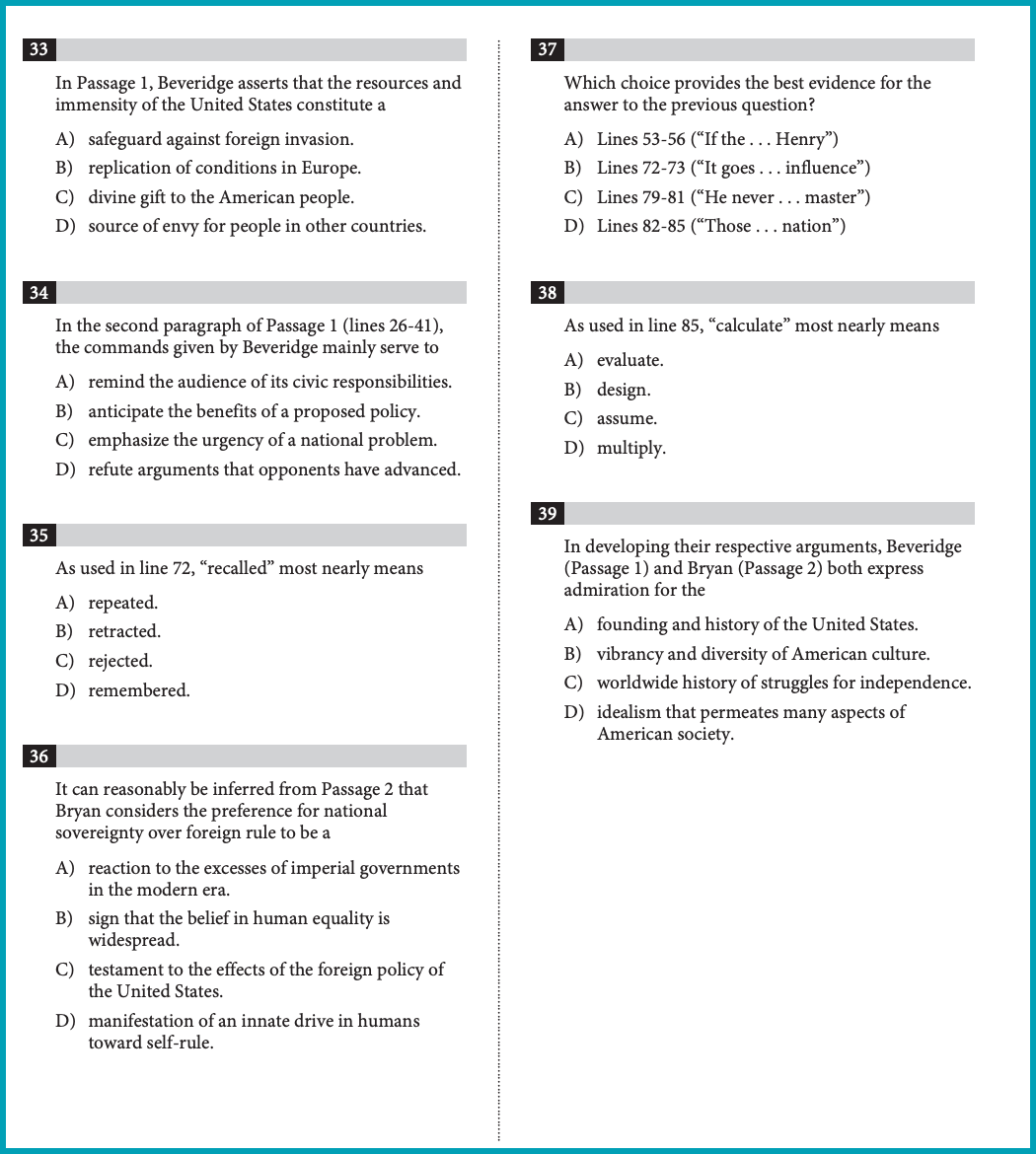
You'll see the questions come right after the passage varying in difficulty. Image Courtesy of Khan Academy
Even though each passage asks 10-11 questions, there are only 3 categories of questions. They are:
💡 Information and Ideas
🗣 Rhetoric
🤝 Synthesis
Information and Ideas Practice Questions
These questions truly test the content on the exam. They focus on one or two pieces of evidence, phrases, words, or themes at a time. These questions ask about main ideas, attention to detail, and relationships throughout the passage.
For the next couple of sections, we will be using this passage.
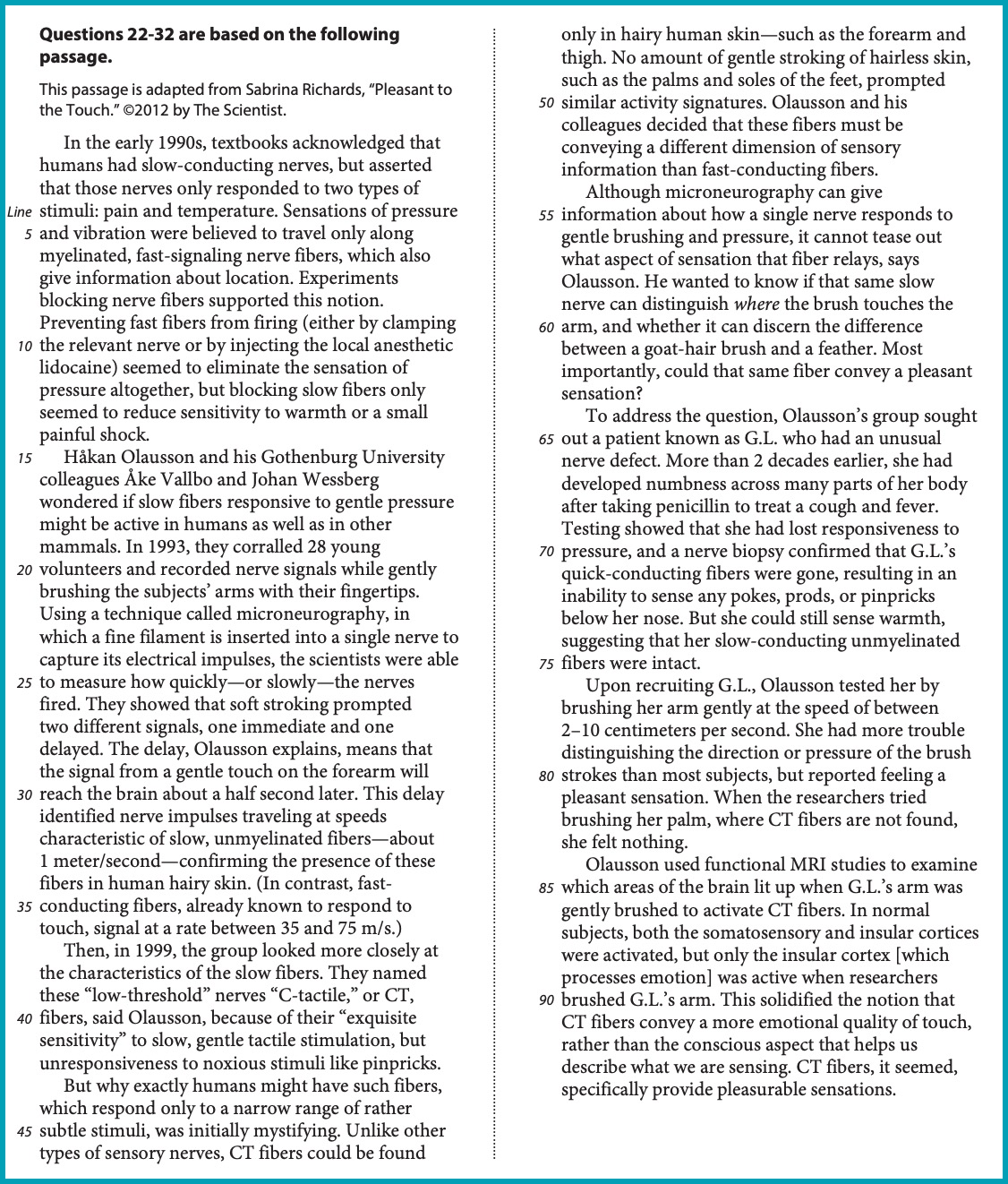
This passage is in practice test #10. Image Courtesy of Khan Academy
Questions can be asked in these general topics:
Reading Closely
The College Board vehemently said to read carefully. Here are the concrete descriptions: Reading Closely Descriptions
🤬 Explicit meaning questions truly test your attention to detail. They test skills such as searching for evidence and understanding the context of the question.
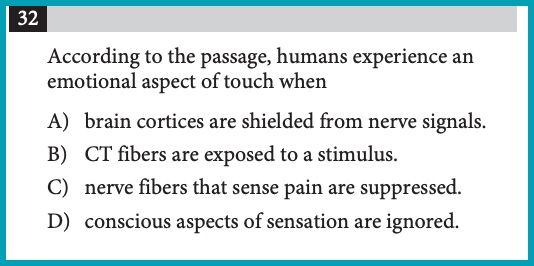
This is an example of an explicit meaning question. Image Courtesy of Khan Academy
Answer & Explanation
This answer is B. According to the last paragraph, parts of the brain lit up when "G.L.'s arm was gently brushed to activate CT fibers," which showed that "CT fibers convey[ed] a more emotional quality of touch rather than the conscious aspect..." The evidence negates and eliminates Choice D. Choice A is incorrect because the passage never indicated that brain cortices are shielded from nerve signals. Choice C is incorrect because of the suppression of the nerve fibers that sense pain did not directly connect to the emotional aspect of touch.
🤫 Implicit meaning questions test whether you understood the passage as a whole and can find evidence to create conclusions.

This is an example of an implicit meaning question. Image Courtesy of Khan Academy
Answer & Explanation
This answer is D. The first paragraph asserts that textbook authors in the early 1990s believed that “sensations of pressure and vibration...travel only along myelinated, fast-signaling nerve fibers.” Thus, they most likely expected that the ability to perceive vibrations would be impaired as a result of blocking fast fibers, eliminating the rest of the choices.
🧠 Analogical reasoning is more of a skill than a question type. You'll have to connect numerous pieces of evidence at one time. You'll not only use this skill in the two question types above but throughout the section.
Strategy for Reading Closely Questions
Ask yourself these questions:
Which ones can I immediately cross out?
Why are they wrong?
Where in the text did it reference terms in the question?
Only looking at the text, which one of these is the better answer?
Why is that the better answer?
These questions are, in essence, very basic arguments. You are creating an argument every time you answer a question. The main point: STICK with your argument, don't second guess yourself.
Citing Textual Evidence
The SAT Reading section is notorious for these questions. You'll provide evidence for the "previous question," or you'll find evidence that best shows a claim or concept.
😭 Citing evidence questions tend to be tricky as two answer choices seem correct. Use your objective lens to only choose your answer based on what's in the text.
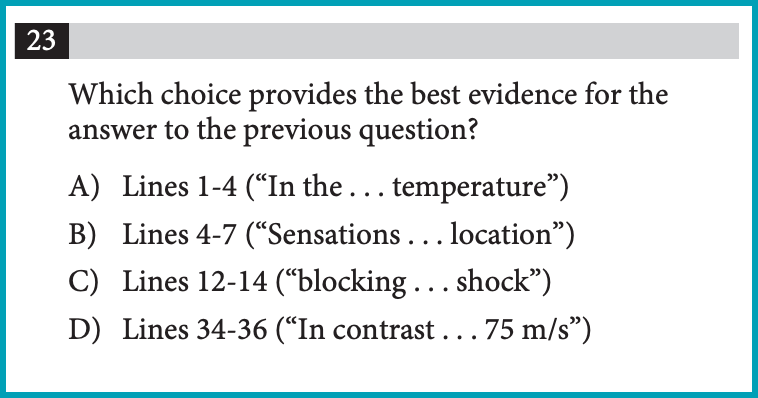
This is an example of a citing evidence question. This question is right after the implicit meaning question above. Image Courtesy of Khan Academy
Answer & Explanation
The correct answer is B. In the previous question, we used the evidence in Choice B to answer the question. The rest of the answer choices don't directly connect to what the textbook authors believed.
Strategy for Citing Evidence Questions
It depends on which of the two citing evidence questions:
Finding Evidence for the Previous Question
Look at the argument you created for the previous question
What pieces of evidence did you use to make your decision?
Are any of those an answer choice?
Is it the best option?
Finding Evidence to Support a Claim
What are the key terms in the question?
Where in the text does it reference the terms in the question?
Narrow down the answer choices
Which best answers the question?
Why?
Asking yourself these questions justifies your answers and decreases the likelihood for you to second guess yourself. It may seem time-consuming or tedious at first, but the more you go through these questions, the faster you'll be able to answer the question.
Determining Central Ideas and Themes
Remember that all the passages mention or embody these themes:
🔬 Research: This shows the results of a study and the commentary from the author. This theme is seen mostly in the social science and science passages.
🇺🇸 Morality & Patriotism: This serves to question a concept or widely accepted idea that may seem correct. This theme shows up in the historical and literary passages.
🤔 Identity & Growth: This usually focuses on a protagonist and shows the issues he/she/they face. This theme shows up in literary passages and historical passages about one or two historical figure(s).
🚨 Societal Issues: This theme portrays the struggle on how communities change over time or if they change at all. This theme is present in literary and science passages.
🌎 Human vs. World: This theme indicates a small change that affects everyone. This theme is present in all three passage types.
The College Board wants you to find the individual explicit and implicit themes of each passage. Depending on the level of complexity, problems can arise. Using these umbrella themes above, you'll have a shortcut to answering questions.
🙀 Theme and Idea questions, depending on the answer choices, vary in complexity.
Strategy for Theme and Idea Questions
Passages always show some form of discovery. To tackle these questions, you must look for shifts in the passage. These shifts may look like lessons learned or major events that affect the characters altogether. Ask yourself these questions:
What changed from the beginning to the end of passage?
How did the protagonist change? If so, what changed him/her/them?
What was the purpose of the last couple of paragraphs?
By answering these questions, you are creating a sequence of events that have significance. In the end, a clear theme or idea will be present.
For the next couple of sections, we will be using this passage:
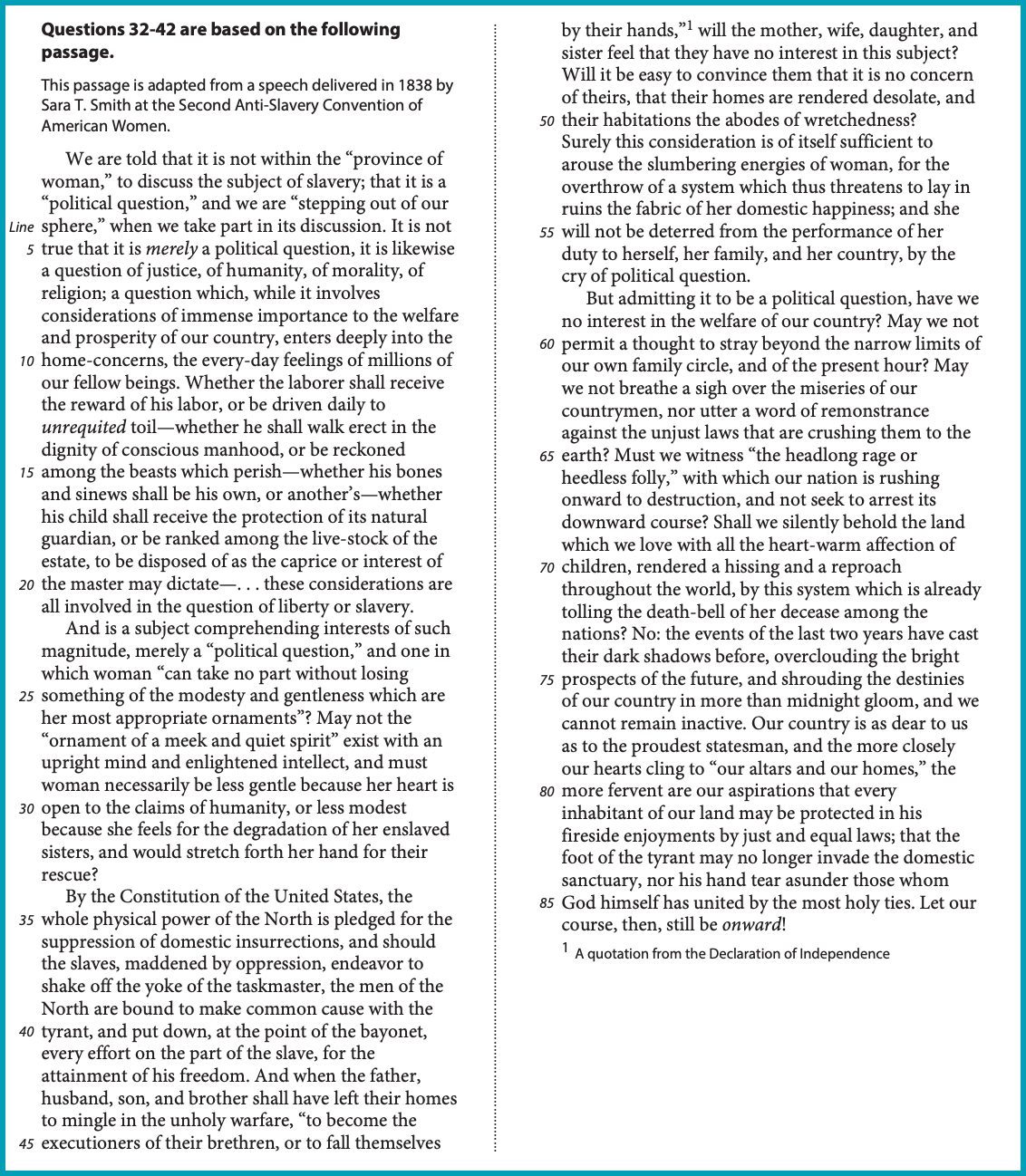
This is an example of a history passage. Image Courtesy of Khan Academy
Summarizing
Throughout the section, you'll face questions that ask to summarize a part of the text or the text as a whole.
📜 Summary questions test whether you were able to fully understand the key elements of the text and piece together the important details of the text.
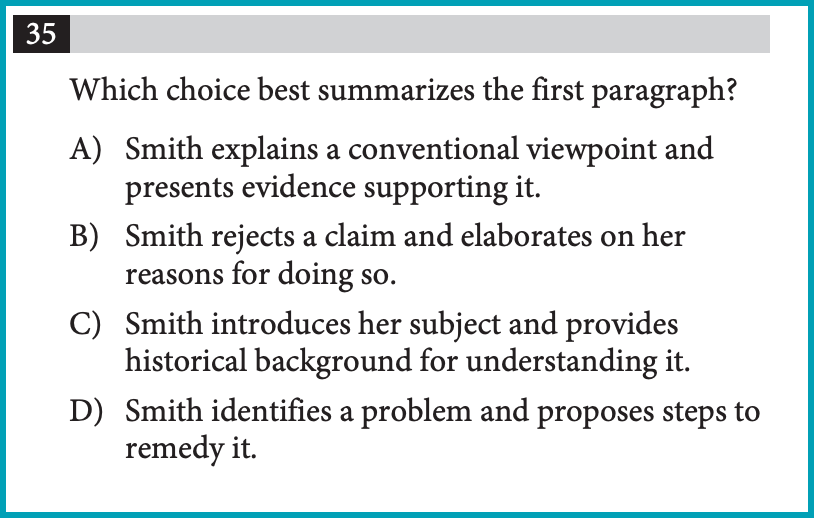
Summary questions can vary in complexity—pay very close attention. Image Courtesy of Khan Academy
Answer & Explanation
The answer is B. At the beginning of the passage, Smith introduces that the subject of slavery is a "political issue." However, she continues in the next sentence that "it is not merely a political issue." Smith truly never identifies a problem other than slavery but does not propose steps, eliminating Choice D. Smith really introduces a non-conventional viewpoint, broadening the idea of slavery beyond a political problem and eliminating Choice A. The paragraph does not reference any historical events related to slavery; therefore, Choice C is incorrect.
Strategy for Summary Questions
Summary questions test whether or not you can only objectively look at the text. Here are some tips to tackle these questions:
Topic Sentences: Topic sentences usually introduce the idea for that paragraph.
Last Couple of Sentences: Focus on the last couple of sentences. Compare those to the topic sentence. What changed? What developed?
Repetition: Look at repeated terms or numerously referenced information.
Understanding Relationships
The questions of the reading section, in essence, are built on cause-effect and compare-contrast relationships.
♥ Relationship questions test whether you're able to sequence events together and identify effects that shape the content.

This question shows a cause-effect relationship. Image Courtesy of Khan Academy
Answer & Explanation
The answer is A. In the last paragraph, Smith references a "rendered hissing and a reproach throughout the world" as slavery takes a toll on this land. She is taking about the US is being judged for what slavery has done to the country. Choice B is incorrect as, in the third paragraph, Smith states the effects of slavery are a sufficient consideration to "overthrow a system," not the country. Although Smith ominously talks about the past, she mentions no conflicts or specific areas where conflict occurs.
Strategy for Relationship Questions
Ask yourself these questions to narrow down your answer choices:
If it's cause and effect...
What was the direct effect of the event mentioned?
What evidence is present?
Is that evidence specific enough?
If it's compare and contrast (paired set)...
What are the main ideas of each passage?
What are the similarities? What are the difference?
What do they agree and disagree on?
How does the concept in question function in both passages?
These questions offer you a way to justify your answer.
Interpreting Words and Phrases in Context
The College Board tests your ability to understand parts of the text in context.
😊 In-context questions test if you're able to understand how phrases and words function in a sentence, paragraph, and the text as a whole.
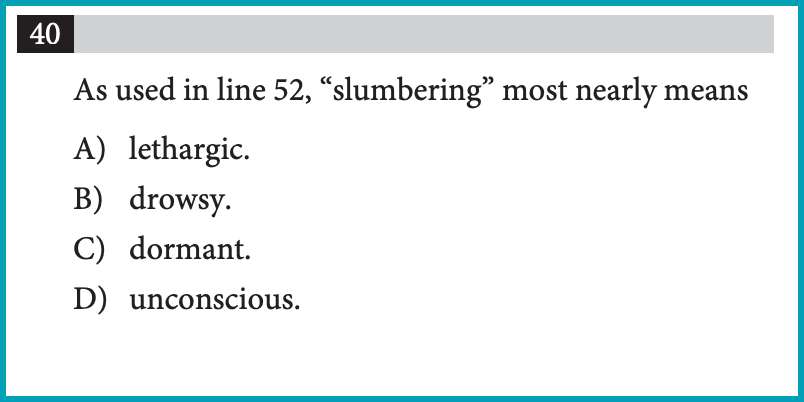
In-context questions can look like this or ask about phrases. Image Courtesy of Khan Academy
Answer & Explanation
The answer is C. In the context of the passage, Smith shows how the effects of slavery "arouse" the energies of women. Arouse means to stimulate. Choices A and B are too similar to be one of the answer choices, and they do not have the correct tone for the passage. Smith is an example of women conscious of what's happening in the US. As a result, Choice D is incorrect.
Strategy for In-Context Questions
Here are some tips to tackle these questions:
Look before and after: Read a couple of sentences before and after the word is used. This will help you understand the tone and context in which the word was used.
Replace and check: Replace the word with one of the answer choices to see if the context and tone are maintained.
If tackled properly, these can be easy questions.
Rhetoric Practice Questions
These questions test your ability to understand the author's choices and how they shape the text as a whole. These questions tend to focus on examining word choice, text structure, point of view, purpose, and arguments.
In this section, we'll look at what the questions look like and how to tackle them.
Analyzing Word Choice
Everything the author does in the text is a choice. He/she/they chose to add a detail here or structure a sentence in a certain way on purpose.
🕧 Word-choice analysis questions tend to focus on the phrases and words within the text function or shape the tone of the paragraph.
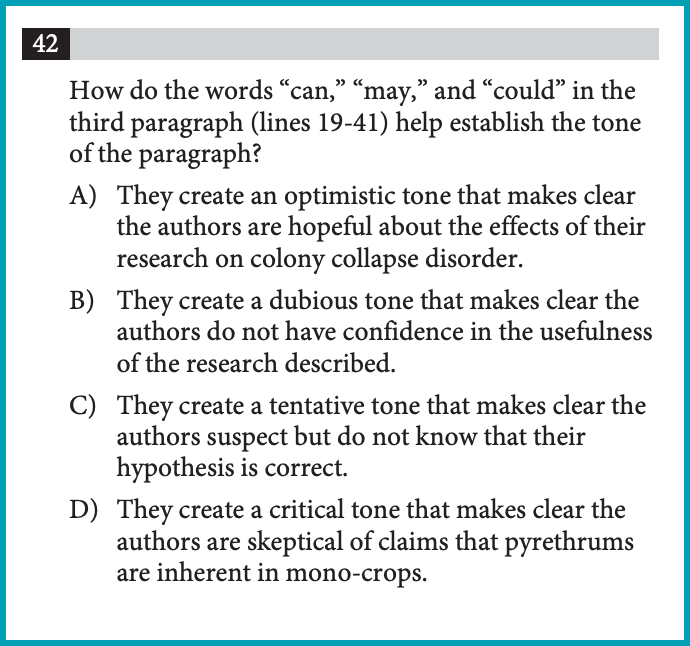
Take a look how these word can create a certain tone in the passage. Image Courtesy of Khan Academy
Strategy for Word Choice Analysis Questions
The College Board can ask these questions in numerous ways. However, here are some tips to keep in mind regardless of the question:
Context: What is the context of the paragraph? How does that paragraph provide significance or function overall in the passage?
Before and After: What was the paragraph before about? What was the paragraph after about? Was there a shift?
Diction: Was there strong diction or lack thereof in the paragraph? What was the purpose of the diction in that paragraph?
In general, you should be familiar with numerous tone words. Here's a list for you:
Table of Tone Words
Table Courtesy of https://dickesryan.wordpress.com/la/tone/
Analyzing Text Structure
The College Board likes to test the how certain parts of the text function overall in the passage. Here are the descriptions for what entails:
Text Structure Descriptions
👉🏽 👈🏽 Overall text questions test your ability to see shifts in the passage while identifying key details.
🙆🏽 Part-whole questions focus on the significance in the passage.
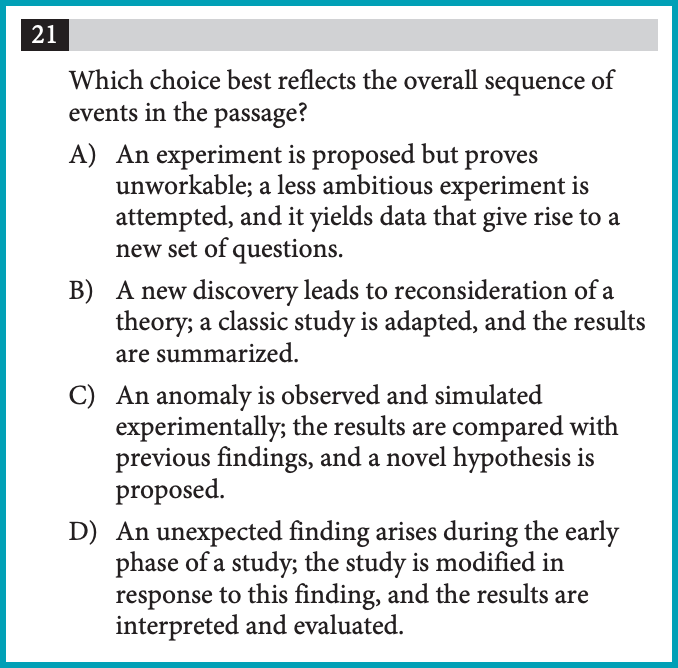
Overall text questions usually are asked through a sequence of events. Image Courtesy of Khan Academy

Part-whole questions mainly ask about the function of a part of the text. Image Courtesy of Khan Academy
Strategy for Text Structure Questions
For overall text questions:
Beginning to End: How does the passage start? How does it end?
Topic sentences: Read all the topic sentences as they can give you a hint of a shift that occurs.
Rudimentary Summary: In essence, a sequence of events is a summary of the passage.
Best answer: There is only one correct answer. The answer is 100% correct based on the passage and is the best answer to the question.
For part-whole questions:
Context: You must read the paragraph before the section to understand its significance.
Themes: Remember the theme list from earlier? What theme is emerging the most throughout the passage? How do these lines play a role in that?
Analyzing Point of View
📷 Perspective questions focus on complex and inferential situations.
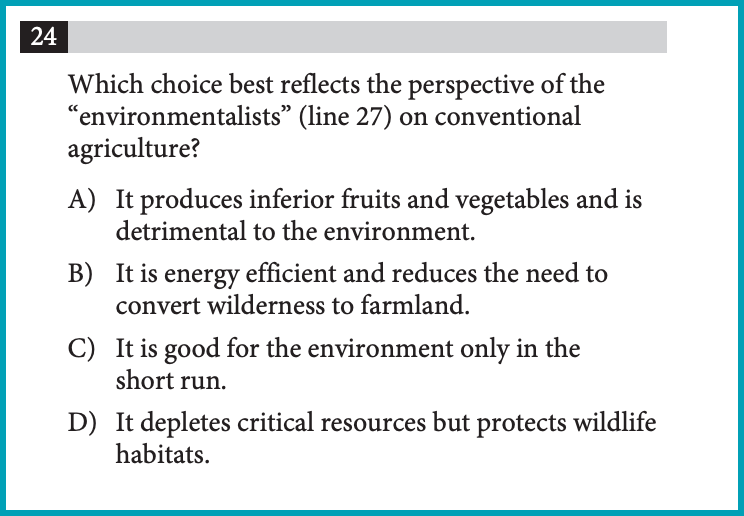
Perspective questions can ask about a group referenced in the passage. Image Courtesy of Khan Academy

Perspective questions can ask about how others are viewed. Image Courtesy of Khan Academy
Strategy for Perspective Questions
Here are some tips to conquer these questions:
Build a Persona: Take everyone that was mentioned in the passage, and create a mental image of them. Ask: Where were they mentioned? Why were they mentioned? Who are they? What value do they add?
Context: What happened before they were mentioned? How were they introduced?
⁉ Analyzing Purpose
⚡ Purpose questions focus on value added by the text or some parts of it.
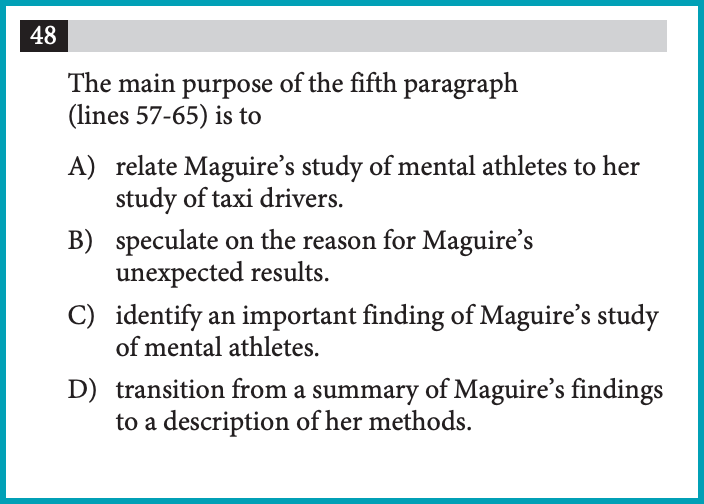
Usually, these questions will ask about a specific paragraph. Image Courtesy of Khan Academy
Strategy for Purpose Questions
Use these tips to ace these questions:
- Main idea: What was the paragraph talking about? How did that shape the text as a whole? What were the main ideas in the passage?
- Before and After: What was the paragraph before about? What about the paragraph after? What emerged from the introduction to the conclusion?
- Ending: How did the paragraph end? What was the key takeaway? What did key takeaways support?
Analyzing Arguments
While reading, you must be able to construct the argument the author is making. The College Board tests you on your ability to understand, qualify, and add to an argument. Here are the descriptions:
Analyzing Argument Description
💥 Claim questions focus on the value of a statement overall in the passage.
💀 Analyzing evidence questions focus on whether pieces of evidence support the argument in the passage.
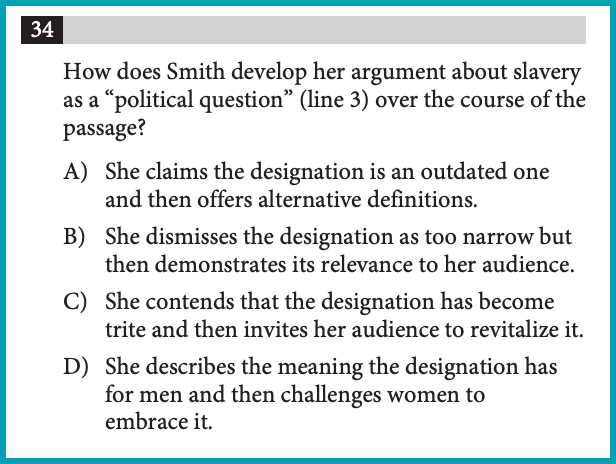
This is a claim question. Image Courtesy of Khan Academy
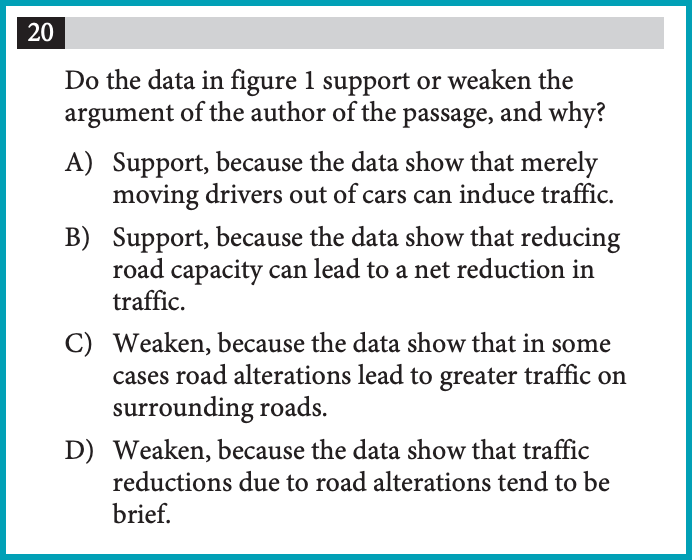
This is an example of an analyzing evidence question. Image Courtesy of Khan Academy
Strategy for Analyzing Argument Questions
Answering a question is an argument, which has multiple perspectives and pieces of evidence. Here's what you need to do:
Look at the wording: Eliminate some answer choices by how they're structured. Remember that the wording has to be 100% true in the context of the passage, not what we think about the wording.
Main Ideas: List out all of the main ideas of the passage. Ask yourself: how do these pieces of evidence play into these main ideas?
If they don't, they probably support a counterclaim and will not be the correct answer.
Synthesis Practice Questions
These types of questions focus on simplifying information and providing the significance of the information.
Analyzing Multiple Texts
Synthesizing information from numerous texts is a skill that the College Board tests through the paired set. Understanding how they relate to one another is crucial when answering related questions.
Analyzing Quantitative Information
Quantitative information can come in the form of a table, chart, or graph. Also, questions can ask about quantitative information in the passage.
📈 Quantitative questions show whether you're able to connect the visual representations to the passage.
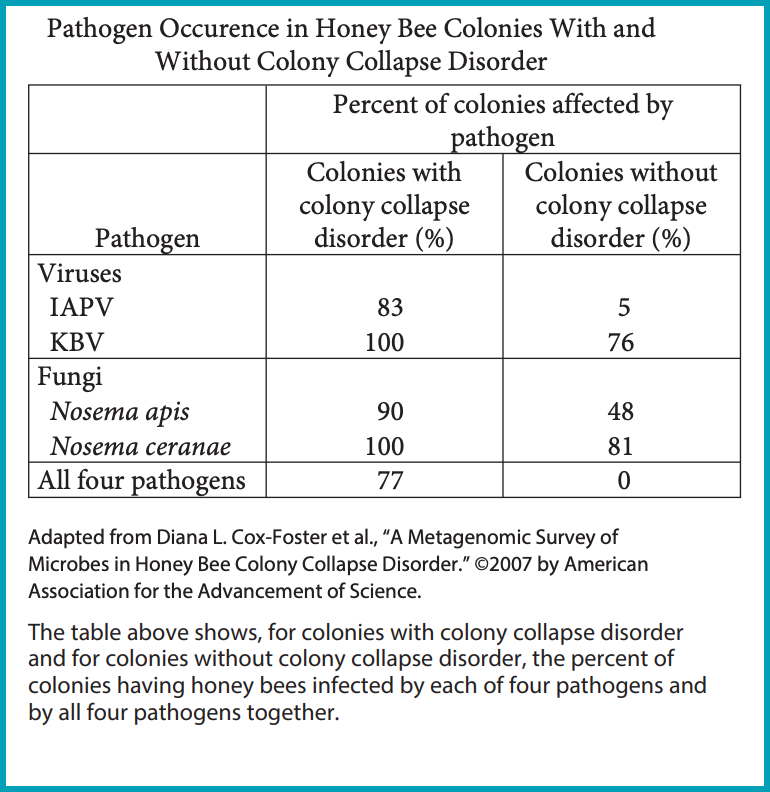
This is an example of a table. Image Courtesy of Khan Academy
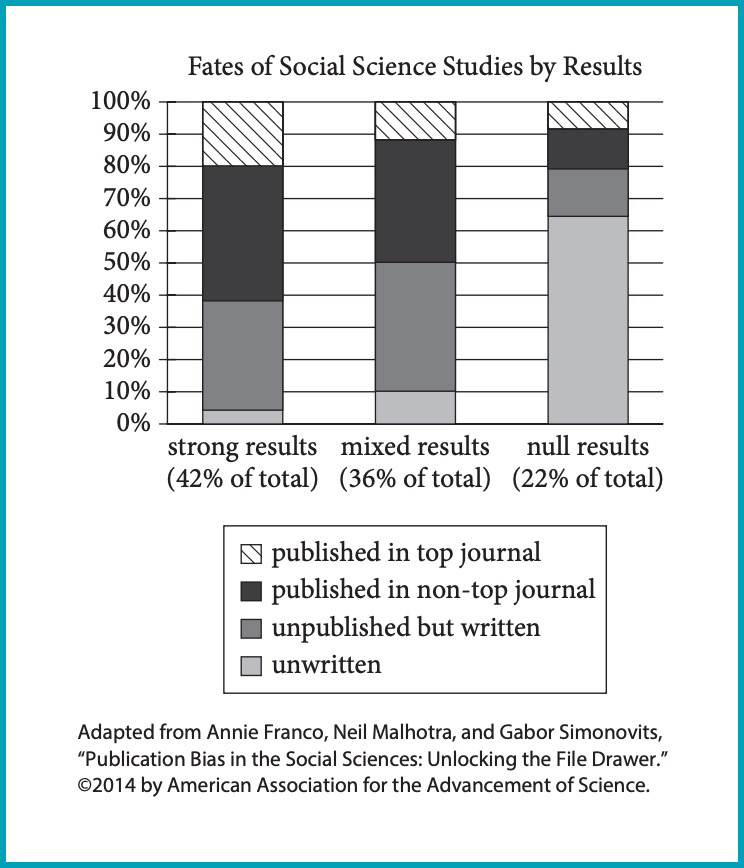
Quantitative data can come in forms of these graphs. Image Courtesy of Khan Academy
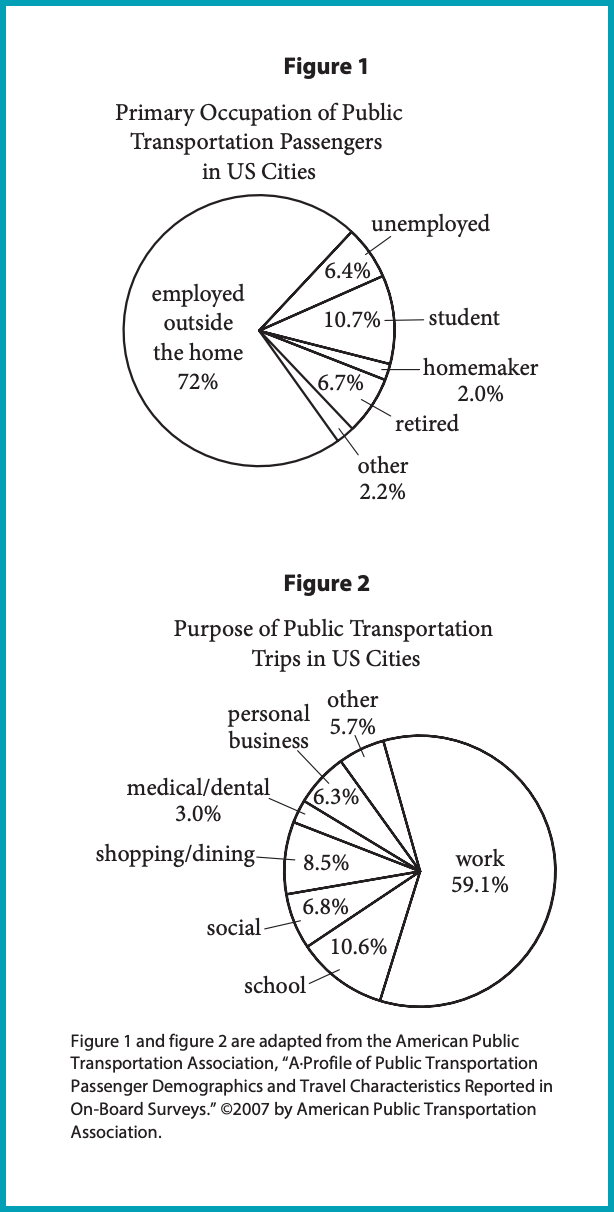
Expect any form of graphical representation to be used in this section. Image Courtesy of Khan Academy
Strategy for Quantitative Information
Read EVERYTHING: Do not just go straight to the figure. Read the key and the paragraphs underneath it. They may give information that can help answer these questions.
Back to the Passage: Re-read the places where the results/data are referenced. These places may give you context to justify your answer.
SAT Reading Sample Passage and Scoring
Set a timer for 12 minutes to read this passage and answer the following questions. You got this!
Questions 1-10 are based on the following passage.
This passage is adapted from Patricia Waldron, “Why Birds Fly in a V Formation.” ©2014 by American Association for the Advancement of Science.
Anyone watching the autumn sky knows that migrating birds fly in a V formation, but scientists have long debated why. A new study of ibises finds that these big-winged birds carefully position their wingtips and sync their flapping, presumably to catch the preceding bird’s updraft—and save energy during flight.
There are two reasons birds might fly in a V formation: It may make flight easier, or they’re simply following the leader. Squadrons of planes can save fuel by flying in a V formation, and many scientists suspect that migrating birds do the same. Models that treated flapping birds like fixed-wing airplanes estimate that they save energy by drafting off each other, but currents created by airplanes are far more stable than the oscillating eddies coming off of a bird. “Air gets pretty unpredictable behind a flapping wing,” says James Usherwood, a locomotor biomechanist at the Royal Veterinary College at the University of London in Hatfield, where the research took place.
The study, published in Nature, took advantage of an existing project to reintroduce endangered northern bald ibises (Geronticus eremita) to Europe. Scientists used a microlight plane to show hand-raised birds their ancestral migration route from Austria to Italy. A flock of 14 juveniles carried data loggers specially built by Usherwood and his lab. The device’s GPS determined each bird’s flight position to within 30 cm, and an accelerometer showed the timing of the wing flaps.
Just as aerodynamic estimates would predict, the birds positioned themselves to fly just behind and to the side of the bird in front, timing their wing beats to catch the uplifting eddies. When a bird flew directly behind another, the timing of the flapping reversed so that it could minimize the effects of the downdraft coming off the back of the bird’s body. “We didn’t think this was possible,” Usherwood says, considering that the feat requires careful flight and incredible awareness of one’s neighbors. “Perhaps these big V formation birds can be thought of quite like an airplane with wings that go up and down.”
The findings likely apply to other long-winged birds, such as pelicans, storks, and geese, Usherwood says. Smaller birds create more complex wakes that would make drafting too difficult. The researchers did not attempt to calculate the bird’s energy savings because the necessary physiological measurements would be too invasive for an endangered species. Previous studies estimate that birds can use 20 percent to 30 percent less energy while flying in a V.
“From a behavioral perspective it’s really a breakthrough,” says David Lentink, a mechanical engineer at Stanford University in Palo Alto, California, who was not involved in the work. “Showing that birds care about syncing their wing beats is definitely an important insight that we didn’t have before.”
Scientists do not know how the birds find that aerodynamic sweet spot, but they suspect that the animals align themselves either by sight or by sensing air currents through their feathers. Alternatively, they may move around until they find the location with the least resistance. In future studies, the researchers will switch to more common birds, such as pigeons or geese. They plan to investigate how the animals decide who sets the course and the pace, and whether a mistake made by the leader can ripple through the rest of the flock to cause traffic jams.
“It’s a pretty impressive piece of work as it is, but it does suggest that there’s a lot more to learn,” says Ty Hedrick, a biologist at the University of North Carolina, Chapel Hill, who studies flight aerodynamics in birds and insects. However they do it, he says, “birds are awfully good hang-glider pilots.”
1.) The main purpose of the passage is to
A) describe how squadrons of planes can save fuel by flying in a V formation.
B) discuss the effects of downdrafts on birds and airplanes.
C) explain research conducted to study why some birds fly in a V formation.
D) illustrate how birds sense air currents through their feathers.
2.) The author includes the quotation “Air gets pretty unpredictable behind a flapping wing” (lines 17-18) to
A) explain that the current created by a bird differs from that of an airplane.
B) stress the amount of control exerted by birds flying in a V formation.
C) indicate that wind movement is continuously changing.
D) emphasize that the flapping of a bird’s wings is powerful.
3.) What can reasonably be inferred about the reason Usherwood used northern bald ibises as the subjects of his study?
A) The ibises were well acquainted with their migration route.
B) Usherwood knew the ibises were familiar with carrying data loggers during migration.
C) The ibises have a body design that is similar to that of a modern airplane.
D) The ibises were easily accessible for Usherwood and his team to track and observe.
4.) Which choice provides the best evidence for the answer to the previous question?
A) Lines 3-7 (“A new . . . flight”)
B) Lines 10-12 (“Squadrons... same”)
C) Lines 22-24 (“The study... Europe”)
D) Lines 29-31 (“The device’s... flaps”)
5.) What is the most likely reason the author includes the 30 cm measurement in line 30?
A) To demonstrate the accuracy with which the data loggers collected the data
B) To present recorded data about how far an ibis flies between successive wing flaps
C) To provide the wingspan length of a juvenile ibis
D) To show how far behind the microlight plane each ibis flew
6.) What does the author imply about pelicans, storks, and geese flying in a V formation?
A) They communicate with each other in the same way as do ibises.
B) They have the same migration routes as those of ibises.
C) They create a similar wake to that of ibises.
D) They expend more energy than do ibises.
7.) Which choice provides the best evidence for the answer to the previous question?
A) Lines 35-38 (“When... body”)
B) Lines 47-48 (“Smaller... difficult”)
C) Lines 52-54 (“Previous . . . a V”)
D) Lines 66-67 (“Alternatively... resistance”)
8.) What is a main idea of the seventh paragraph (lines 62-73)?
A) Different types of hierarchies exist in each flock of birds.
B) Mistakes can happen when long-winged birds create a V formation.
C) Future research will help scientists to better understand V formations.
D) Long-winged birds watch the lead bird closely to keep a V formation intact.
9.) The author uses the phrase “aerodynamic sweet spot” in line 63 most likely to
A) describe how the proper structural design of an airplane helps to save fuel.
B) show that flying can be an exhilarating experience.
C) describe the birds’ synchronized wing movement.
D) suggest that a certain position in a V formation has the least amount of wind resistance.
10.) As used in line 72, “ripple” most nearly means
A) fluctuate.
B) spread.
C) wave.
D) undulate.
Solutions
C
A
D
C
A
C
B
C
D
B
Wrap Up
And that's it! You have successfully acquired the skills to improve your SAT score and get an 800 on the reading section. Make sure to keep on practicing and using the strategies stated in this guide.
Need more resources? Check out our 5 best resources for PSAT/SAT English sections. Pressed on time? Learn how to cram to get an 800 on SAT humanities and watch the Night Before the SAT cram session. You got this 🥳.
Fiveable's SAT Reading Section Overview
22 min read•august 24, 2021
Aly Moosa
Aly Moosa
What are the SAT Sections?
In the SAT, you will have 4-5 sections on the test (depending on whether you choose to take the essay section or not)! The sections are:
Reading
Writing and Language (aka the grammar section)
Math (no calculator)
Math (calculator allowed)
Writing/Essay (⚠️ OPTIONAL ⚠️)
The reading section is arguably one of the more difficult sections out of the whole test. Many students struggle with this section, but in this study guide, you will learn about logistics, strategies, and general tips to ace this section! For more help on the SAT, check out our SAT cram sessions!
SAT Reading Section Passages
The new SAT reading section tests your reading comprehension while racing against the clock, answering 65 questions in 52 minutes' time. In total, there are 4 passages and 1 paired set (2 passages), each containing around 500-750 words and 10-11 questions. The SAT reading section is scored out of 800 points. If you're feeling overwhelmed already, check out Lisa Wang's SAT Reading and Writing livestream to get started!
Throughout the exam, the passages will cover one or many of the following themes:
🔬 Research: This shows the results of a study and the commentary from the author. This theme is seen mostly in the social science and science passages.
🇺🇸 Morality & Patriotism: This serves to question a concept or widely accepted idea that may seem correct. This theme shows up in the historical and literary passages.
🤔 Identity & Growth: This usually focuses on a protagonist and shows the issues he/she/they face. This theme shows up in literary passages and historical passages about one or two historical figure(s).
🚨 Societal Issues: This theme portrays the struggle on how communities change over time or if they change at all. This theme is present in literary and science passages.
🌎 Human vs. World: This theme indicates a small change that affects everyone. This theme is present in all three passage types.
These themes serve as broad overarching umbrellas that will aid you in understanding the passage and answering questions. One passage may encompass only one or multiple themes, increasing the complexity of the passage and questions overall.
Themes are shown in these three passage types:
📚 US and World Literature: These are fictional passages that tend to focus on overarching external and numerous internal conflicts. Works featured could be centuries old or recently published.
👺 History/Social Studies: For our sake, we'll break this down into History and Social Science.
✨ Social Science: These deal with matters in psychology, geography, economics, law, linguistics, etc. They usually challenge the reader's critical thinking skills and attention to detail.
✊🏽 History: These typically are arguments, speeches, letters, referendums from historical figures.
🧪 Science: These deal with matters in fields in science in fields of computer science, physics, chemistry, biology, astronomy, and earth science.
These passages vary in complexity from test to test, but all contain the same fundamentals, making it simple to tackle and master these passages.
Reading Section Tips
You can use these tips on any SAT reading passage:
1. Make Complex Simple
Paragraph by paragraph: Since each passage has around 500 words, it's crucial to take it one paragraph at a time. Don't rush through the passage.
Annotate: Jot down notes in the margin, underline key terms and phrases, circle repetition, and put a question mark by confusing places. You will experience some form of difficulty while reading, which is normal.
2. Timing
Pace Yourself: You have 65 minutes to cover 4 passages and 1 paired set. You should spend 12 minutes total on one passage, leaving 17 minutes for the paired set. You should spend 3-4 minutes just reading the passage.
Answer everything: DO NOT leave any question unanswered. You do not get penalized for answering incorrectly.
3. Breathe
Stop and Continue: Struggling is normal during this section. When you do, do not continue reading. Stop yourself and breathe. Restart at the beginning of the paragraph you were on and push on.
Re-read: Mark places where you need to re-read or come back to.
SAT Practice Questions

You'll see the questions come right after the passage varying in difficulty. Image Courtesy of Khan Academy
Even though each passage asks 10-11 questions, there are only 3 categories of questions. They are:
💡 Information and Ideas
🗣 Rhetoric
🤝 Synthesis
Information and Ideas Practice Questions
These questions truly test the content on the exam. They focus on one or two pieces of evidence, phrases, words, or themes at a time. These questions ask about main ideas, attention to detail, and relationships throughout the passage.
For the next couple of sections, we will be using this passage.

This passage is in practice test #10. Image Courtesy of Khan Academy
Questions can be asked in these general topics:
Reading Closely
The College Board vehemently said to read carefully. Here are the concrete descriptions: Reading Closely Descriptions
🤬 Explicit meaning questions truly test your attention to detail. They test skills such as searching for evidence and understanding the context of the question.

This is an example of an explicit meaning question. Image Courtesy of Khan Academy
Answer & Explanation
This answer is B. According to the last paragraph, parts of the brain lit up when "G.L.'s arm was gently brushed to activate CT fibers," which showed that "CT fibers convey[ed] a more emotional quality of touch rather than the conscious aspect..." The evidence negates and eliminates Choice D. Choice A is incorrect because the passage never indicated that brain cortices are shielded from nerve signals. Choice C is incorrect because of the suppression of the nerve fibers that sense pain did not directly connect to the emotional aspect of touch.
🤫 Implicit meaning questions test whether you understood the passage as a whole and can find evidence to create conclusions.

This is an example of an implicit meaning question. Image Courtesy of Khan Academy
Answer & Explanation
This answer is D. The first paragraph asserts that textbook authors in the early 1990s believed that “sensations of pressure and vibration...travel only along myelinated, fast-signaling nerve fibers.” Thus, they most likely expected that the ability to perceive vibrations would be impaired as a result of blocking fast fibers, eliminating the rest of the choices.
🧠 Analogical reasoning is more of a skill than a question type. You'll have to connect numerous pieces of evidence at one time. You'll not only use this skill in the two question types above but throughout the section.
Strategy for Reading Closely Questions
Ask yourself these questions:
Which ones can I immediately cross out?
Why are they wrong?
Where in the text did it reference terms in the question?
Only looking at the text, which one of these is the better answer?
Why is that the better answer?
These questions are, in essence, very basic arguments. You are creating an argument every time you answer a question. The main point: STICK with your argument, don't second guess yourself.
Citing Textual Evidence
The SAT Reading section is notorious for these questions. You'll provide evidence for the "previous question," or you'll find evidence that best shows a claim or concept.
😭 Citing evidence questions tend to be tricky as two answer choices seem correct. Use your objective lens to only choose your answer based on what's in the text.

This is an example of a citing evidence question. This question is right after the implicit meaning question above. Image Courtesy of Khan Academy
Answer & Explanation
The correct answer is B. In the previous question, we used the evidence in Choice B to answer the question. The rest of the answer choices don't directly connect to what the textbook authors believed.
Strategy for Citing Evidence Questions
It depends on which of the two citing evidence questions:
Finding Evidence for the Previous Question
Look at the argument you created for the previous question
What pieces of evidence did you use to make your decision?
Are any of those an answer choice?
Is it the best option?
Finding Evidence to Support a Claim
What are the key terms in the question?
Where in the text does it reference the terms in the question?
Narrow down the answer choices
Which best answers the question?
Why?
Asking yourself these questions justifies your answers and decreases the likelihood for you to second guess yourself. It may seem time-consuming or tedious at first, but the more you go through these questions, the faster you'll be able to answer the question.
Determining Central Ideas and Themes
Remember that all the passages mention or embody these themes:
🔬 Research: This shows the results of a study and the commentary from the author. This theme is seen mostly in the social science and science passages.
🇺🇸 Morality & Patriotism: This serves to question a concept or widely accepted idea that may seem correct. This theme shows up in the historical and literary passages.
🤔 Identity & Growth: This usually focuses on a protagonist and shows the issues he/she/they face. This theme shows up in literary passages and historical passages about one or two historical figure(s).
🚨 Societal Issues: This theme portrays the struggle on how communities change over time or if they change at all. This theme is present in literary and science passages.
🌎 Human vs. World: This theme indicates a small change that affects everyone. This theme is present in all three passage types.
The College Board wants you to find the individual explicit and implicit themes of each passage. Depending on the level of complexity, problems can arise. Using these umbrella themes above, you'll have a shortcut to answering questions.
🙀 Theme and Idea questions, depending on the answer choices, vary in complexity.
Strategy for Theme and Idea Questions
Passages always show some form of discovery. To tackle these questions, you must look for shifts in the passage. These shifts may look like lessons learned or major events that affect the characters altogether. Ask yourself these questions:
What changed from the beginning to the end of passage?
How did the protagonist change? If so, what changed him/her/them?
What was the purpose of the last couple of paragraphs?
By answering these questions, you are creating a sequence of events that have significance. In the end, a clear theme or idea will be present.
For the next couple of sections, we will be using this passage:

This is an example of a history passage. Image Courtesy of Khan Academy
Summarizing
Throughout the section, you'll face questions that ask to summarize a part of the text or the text as a whole.
📜 Summary questions test whether you were able to fully understand the key elements of the text and piece together the important details of the text.

Summary questions can vary in complexity—pay very close attention. Image Courtesy of Khan Academy
Answer & Explanation
The answer is B. At the beginning of the passage, Smith introduces that the subject of slavery is a "political issue." However, she continues in the next sentence that "it is not merely a political issue." Smith truly never identifies a problem other than slavery but does not propose steps, eliminating Choice D. Smith really introduces a non-conventional viewpoint, broadening the idea of slavery beyond a political problem and eliminating Choice A. The paragraph does not reference any historical events related to slavery; therefore, Choice C is incorrect.
Strategy for Summary Questions
Summary questions test whether or not you can only objectively look at the text. Here are some tips to tackle these questions:
Topic Sentences: Topic sentences usually introduce the idea for that paragraph.
Last Couple of Sentences: Focus on the last couple of sentences. Compare those to the topic sentence. What changed? What developed?
Repetition: Look at repeated terms or numerously referenced information.
Understanding Relationships
The questions of the reading section, in essence, are built on cause-effect and compare-contrast relationships.
♥ Relationship questions test whether you're able to sequence events together and identify effects that shape the content.

This question shows a cause-effect relationship. Image Courtesy of Khan Academy
Answer & Explanation
The answer is A. In the last paragraph, Smith references a "rendered hissing and a reproach throughout the world" as slavery takes a toll on this land. She is taking about the US is being judged for what slavery has done to the country. Choice B is incorrect as, in the third paragraph, Smith states the effects of slavery are a sufficient consideration to "overthrow a system," not the country. Although Smith ominously talks about the past, she mentions no conflicts or specific areas where conflict occurs.
Strategy for Relationship Questions
Ask yourself these questions to narrow down your answer choices:
If it's cause and effect...
What was the direct effect of the event mentioned?
What evidence is present?
Is that evidence specific enough?
If it's compare and contrast (paired set)...
What are the main ideas of each passage?
What are the similarities? What are the difference?
What do they agree and disagree on?
How does the concept in question function in both passages?
These questions offer you a way to justify your answer.
Interpreting Words and Phrases in Context
The College Board tests your ability to understand parts of the text in context.
😊 In-context questions test if you're able to understand how phrases and words function in a sentence, paragraph, and the text as a whole.

In-context questions can look like this or ask about phrases. Image Courtesy of Khan Academy
Answer & Explanation
The answer is C. In the context of the passage, Smith shows how the effects of slavery "arouse" the energies of women. Arouse means to stimulate. Choices A and B are too similar to be one of the answer choices, and they do not have the correct tone for the passage. Smith is an example of women conscious of what's happening in the US. As a result, Choice D is incorrect.
Strategy for In-Context Questions
Here are some tips to tackle these questions:
Look before and after: Read a couple of sentences before and after the word is used. This will help you understand the tone and context in which the word was used.
Replace and check: Replace the word with one of the answer choices to see if the context and tone are maintained.
If tackled properly, these can be easy questions.
Rhetoric Practice Questions
These questions test your ability to understand the author's choices and how they shape the text as a whole. These questions tend to focus on examining word choice, text structure, point of view, purpose, and arguments.
In this section, we'll look at what the questions look like and how to tackle them.
Analyzing Word Choice
Everything the author does in the text is a choice. He/she/they chose to add a detail here or structure a sentence in a certain way on purpose.
🕧 Word-choice analysis questions tend to focus on the phrases and words within the text function or shape the tone of the paragraph.

Take a look how these word can create a certain tone in the passage. Image Courtesy of Khan Academy
Strategy for Word Choice Analysis Questions
The College Board can ask these questions in numerous ways. However, here are some tips to keep in mind regardless of the question:
Context: What is the context of the paragraph? How does that paragraph provide significance or function overall in the passage?
Before and After: What was the paragraph before about? What was the paragraph after about? Was there a shift?
Diction: Was there strong diction or lack thereof in the paragraph? What was the purpose of the diction in that paragraph?
In general, you should be familiar with numerous tone words. Here's a list for you:
Table of Tone Words
Table Courtesy of https://dickesryan.wordpress.com/la/tone/
Analyzing Text Structure
The College Board likes to test the how certain parts of the text function overall in the passage. Here are the descriptions for what entails:
Text Structure Descriptions
👉🏽 👈🏽 Overall text questions test your ability to see shifts in the passage while identifying key details.
🙆🏽 Part-whole questions focus on the significance in the passage.

Overall text questions usually are asked through a sequence of events. Image Courtesy of Khan Academy

Part-whole questions mainly ask about the function of a part of the text. Image Courtesy of Khan Academy
Strategy for Text Structure Questions
For overall text questions:
Beginning to End: How does the passage start? How does it end?
Topic sentences: Read all the topic sentences as they can give you a hint of a shift that occurs.
Rudimentary Summary: In essence, a sequence of events is a summary of the passage.
Best answer: There is only one correct answer. The answer is 100% correct based on the passage and is the best answer to the question.
For part-whole questions:
Context: You must read the paragraph before the section to understand its significance.
Themes: Remember the theme list from earlier? What theme is emerging the most throughout the passage? How do these lines play a role in that?
Analyzing Point of View
📷 Perspective questions focus on complex and inferential situations.

Perspective questions can ask about a group referenced in the passage. Image Courtesy of Khan Academy

Perspective questions can ask about how others are viewed. Image Courtesy of Khan Academy
Strategy for Perspective Questions
Here are some tips to conquer these questions:
Build a Persona: Take everyone that was mentioned in the passage, and create a mental image of them. Ask: Where were they mentioned? Why were they mentioned? Who are they? What value do they add?
Context: What happened before they were mentioned? How were they introduced?
⁉ Analyzing Purpose
⚡ Purpose questions focus on value added by the text or some parts of it.

Usually, these questions will ask about a specific paragraph. Image Courtesy of Khan Academy
Strategy for Purpose Questions
Use these tips to ace these questions:
- Main idea: What was the paragraph talking about? How did that shape the text as a whole? What were the main ideas in the passage?
- Before and After: What was the paragraph before about? What about the paragraph after? What emerged from the introduction to the conclusion?
- Ending: How did the paragraph end? What was the key takeaway? What did key takeaways support?
Analyzing Arguments
While reading, you must be able to construct the argument the author is making. The College Board tests you on your ability to understand, qualify, and add to an argument. Here are the descriptions:
Analyzing Argument Description
💥 Claim questions focus on the value of a statement overall in the passage.
💀 Analyzing evidence questions focus on whether pieces of evidence support the argument in the passage.

This is a claim question. Image Courtesy of Khan Academy

This is an example of an analyzing evidence question. Image Courtesy of Khan Academy
Strategy for Analyzing Argument Questions
Answering a question is an argument, which has multiple perspectives and pieces of evidence. Here's what you need to do:
Look at the wording: Eliminate some answer choices by how they're structured. Remember that the wording has to be 100% true in the context of the passage, not what we think about the wording.
Main Ideas: List out all of the main ideas of the passage. Ask yourself: how do these pieces of evidence play into these main ideas?
If they don't, they probably support a counterclaim and will not be the correct answer.
Synthesis Practice Questions
These types of questions focus on simplifying information and providing the significance of the information.
Analyzing Multiple Texts
Synthesizing information from numerous texts is a skill that the College Board tests through the paired set. Understanding how they relate to one another is crucial when answering related questions.
Analyzing Quantitative Information
Quantitative information can come in the form of a table, chart, or graph. Also, questions can ask about quantitative information in the passage.
📈 Quantitative questions show whether you're able to connect the visual representations to the passage.

This is an example of a table. Image Courtesy of Khan Academy

Quantitative data can come in forms of these graphs. Image Courtesy of Khan Academy

Expect any form of graphical representation to be used in this section. Image Courtesy of Khan Academy
Strategy for Quantitative Information
Read EVERYTHING: Do not just go straight to the figure. Read the key and the paragraphs underneath it. They may give information that can help answer these questions.
Back to the Passage: Re-read the places where the results/data are referenced. These places may give you context to justify your answer.
SAT Reading Sample Passage and Scoring
Set a timer for 12 minutes to read this passage and answer the following questions. You got this!
Questions 1-10 are based on the following passage.
This passage is adapted from Patricia Waldron, “Why Birds Fly in a V Formation.” ©2014 by American Association for the Advancement of Science.
Anyone watching the autumn sky knows that migrating birds fly in a V formation, but scientists have long debated why. A new study of ibises finds that these big-winged birds carefully position their wingtips and sync their flapping, presumably to catch the preceding bird’s updraft—and save energy during flight.
There are two reasons birds might fly in a V formation: It may make flight easier, or they’re simply following the leader. Squadrons of planes can save fuel by flying in a V formation, and many scientists suspect that migrating birds do the same. Models that treated flapping birds like fixed-wing airplanes estimate that they save energy by drafting off each other, but currents created by airplanes are far more stable than the oscillating eddies coming off of a bird. “Air gets pretty unpredictable behind a flapping wing,” says James Usherwood, a locomotor biomechanist at the Royal Veterinary College at the University of London in Hatfield, where the research took place.
The study, published in Nature, took advantage of an existing project to reintroduce endangered northern bald ibises (Geronticus eremita) to Europe. Scientists used a microlight plane to show hand-raised birds their ancestral migration route from Austria to Italy. A flock of 14 juveniles carried data loggers specially built by Usherwood and his lab. The device’s GPS determined each bird’s flight position to within 30 cm, and an accelerometer showed the timing of the wing flaps.
Just as aerodynamic estimates would predict, the birds positioned themselves to fly just behind and to the side of the bird in front, timing their wing beats to catch the uplifting eddies. When a bird flew directly behind another, the timing of the flapping reversed so that it could minimize the effects of the downdraft coming off the back of the bird’s body. “We didn’t think this was possible,” Usherwood says, considering that the feat requires careful flight and incredible awareness of one’s neighbors. “Perhaps these big V formation birds can be thought of quite like an airplane with wings that go up and down.”
The findings likely apply to other long-winged birds, such as pelicans, storks, and geese, Usherwood says. Smaller birds create more complex wakes that would make drafting too difficult. The researchers did not attempt to calculate the bird’s energy savings because the necessary physiological measurements would be too invasive for an endangered species. Previous studies estimate that birds can use 20 percent to 30 percent less energy while flying in a V.
“From a behavioral perspective it’s really a breakthrough,” says David Lentink, a mechanical engineer at Stanford University in Palo Alto, California, who was not involved in the work. “Showing that birds care about syncing their wing beats is definitely an important insight that we didn’t have before.”
Scientists do not know how the birds find that aerodynamic sweet spot, but they suspect that the animals align themselves either by sight or by sensing air currents through their feathers. Alternatively, they may move around until they find the location with the least resistance. In future studies, the researchers will switch to more common birds, such as pigeons or geese. They plan to investigate how the animals decide who sets the course and the pace, and whether a mistake made by the leader can ripple through the rest of the flock to cause traffic jams.
“It’s a pretty impressive piece of work as it is, but it does suggest that there’s a lot more to learn,” says Ty Hedrick, a biologist at the University of North Carolina, Chapel Hill, who studies flight aerodynamics in birds and insects. However they do it, he says, “birds are awfully good hang-glider pilots.”
1.) The main purpose of the passage is to
A) describe how squadrons of planes can save fuel by flying in a V formation.
B) discuss the effects of downdrafts on birds and airplanes.
C) explain research conducted to study why some birds fly in a V formation.
D) illustrate how birds sense air currents through their feathers.
2.) The author includes the quotation “Air gets pretty unpredictable behind a flapping wing” (lines 17-18) to
A) explain that the current created by a bird differs from that of an airplane.
B) stress the amount of control exerted by birds flying in a V formation.
C) indicate that wind movement is continuously changing.
D) emphasize that the flapping of a bird’s wings is powerful.
3.) What can reasonably be inferred about the reason Usherwood used northern bald ibises as the subjects of his study?
A) The ibises were well acquainted with their migration route.
B) Usherwood knew the ibises were familiar with carrying data loggers during migration.
C) The ibises have a body design that is similar to that of a modern airplane.
D) The ibises were easily accessible for Usherwood and his team to track and observe.
4.) Which choice provides the best evidence for the answer to the previous question?
A) Lines 3-7 (“A new . . . flight”)
B) Lines 10-12 (“Squadrons... same”)
C) Lines 22-24 (“The study... Europe”)
D) Lines 29-31 (“The device’s... flaps”)
5.) What is the most likely reason the author includes the 30 cm measurement in line 30?
A) To demonstrate the accuracy with which the data loggers collected the data
B) To present recorded data about how far an ibis flies between successive wing flaps
C) To provide the wingspan length of a juvenile ibis
D) To show how far behind the microlight plane each ibis flew
6.) What does the author imply about pelicans, storks, and geese flying in a V formation?
A) They communicate with each other in the same way as do ibises.
B) They have the same migration routes as those of ibises.
C) They create a similar wake to that of ibises.
D) They expend more energy than do ibises.
7.) Which choice provides the best evidence for the answer to the previous question?
A) Lines 35-38 (“When... body”)
B) Lines 47-48 (“Smaller... difficult”)
C) Lines 52-54 (“Previous . . . a V”)
D) Lines 66-67 (“Alternatively... resistance”)
8.) What is a main idea of the seventh paragraph (lines 62-73)?
A) Different types of hierarchies exist in each flock of birds.
B) Mistakes can happen when long-winged birds create a V formation.
C) Future research will help scientists to better understand V formations.
D) Long-winged birds watch the lead bird closely to keep a V formation intact.
9.) The author uses the phrase “aerodynamic sweet spot” in line 63 most likely to
A) describe how the proper structural design of an airplane helps to save fuel.
B) show that flying can be an exhilarating experience.
C) describe the birds’ synchronized wing movement.
D) suggest that a certain position in a V formation has the least amount of wind resistance.
10.) As used in line 72, “ripple” most nearly means
A) fluctuate.
B) spread.
C) wave.
D) undulate.
Solutions
C
A
D
C
A
C
B
C
D
B
Wrap Up
And that's it! You have successfully acquired the skills to improve your SAT score and get an 800 on the reading section. Make sure to keep on practicing and using the strategies stated in this guide.
Need more resources? Check out our 5 best resources for PSAT/SAT English sections. Pressed on time? Learn how to cram to get an 800 on SAT humanities and watch the Night Before the SAT cram session. You got this 🥳.

Resources
© 2024 Fiveable Inc. All rights reserved.
AP® and SAT® are trademarks registered by the College Board, which is not affiliated with, and does not endorse this website.